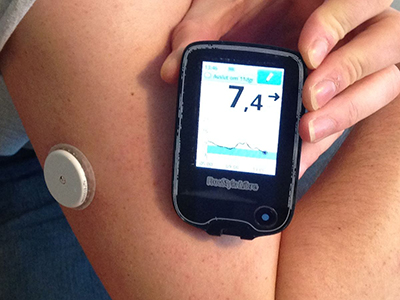
NHS postcode lottery denies thousands of diabetics blood sugar monitor patches (Photo: Sjö/Wiki CC)
Tens of thousands of people with Type 1 diabetes are being put at increased risk of serious complications due to rationing of a blood sugar monitoring patch.
The blood glucose monitor is worn as a patch on the skin and transmits readings to a portable reader so the wearer can monitor their blood glucose levels. It reduces the need for finger prick blood tests and helps people manage their condition more effectively.
However, many people in certain parts of the country are denied access to the monitor on the NHS due to local healthcare authorities not prioritising funding for it.
There are 300,000 people in England who have Type 1 diabetes and initial research suggested around 20 to 25% were eligible for the glucose monitoring patch, but a recent investigation has revealed that only around 3 to 5% of Type 1 patients in England had access to the monitors on the NHS, despite it being made available last November.
The investigation found that in some regions of the country people were not given access to the monitor as some local clinical commissioning groups decided not to prioritise funding of the devices.
NHS England said the device would now be funded to allow access throughout the country in all 195 clinical commissioning groups, allowing tens of thousands of more people with Type 1 diabetes to use the monitors from April 2019.
How does it work?
The Freestyle Libre flash glucose monitoring system was made available on the NHS last November. The glucose monitoring device works via a tiny sensor inserted under the skin, which is connected to a small transmitter patch, about the size of a 2 pence coin, on the surface of the skin.
The sensor reads the blood sugar levels of the fluid just beneath the skin, the transmitter then sends this reading wirelessly to a portable monitor. By monitoring their blood sugar levels people can more effectively manage their diabetes. It replaces the need for finger prick tests, which often need to be performed many times throughout the day. It also enables the user to see if their blood sugar levels are going up or down or remaining constant helping to give a better indication of blood sugar levels over the course of the day.
The Prime Minister Theresa May, who has Type 1 diabetes, was photographed wearing the monitor on her upper arm when she attended a dinner with President Donald Trump in July.
Type 1 diabetes
Type 1 diabetes happens when your body can’t produce enough of a hormone called insulin, which controls blood glucose. You need daily injections of insulin to keep your blood glucose levels under control and stop them from becoming too high.
Managing Type 1 diabetes can take time to get used to as you need to keep monitoring blood glucose levels to check if you need insulin; keeping blood glucose levels within a set range is essential as raised glucose levels can lead to other health complications.
The Health Secretary, Matt Hancock, recently said in a speech that more money needs to be spent on prevention rather than treating diseases in order to make the NHS more cost effective in the long run.
Commenting on the glucose monitoring system he said: “Rolling out these monitors will not only make life more convenient, it will save the NHS time and resources by preventing people becoming ill in the first place.”
Type 1 diabetes is an autoimmune condition, where the immune system incorrectly attacks the cells in the pancreas that produce insulin. It is not clear why autoimmune diseases such as this occur but in the case of Type 1 diabetes, the result is the body cannot produce insulin and therefore control blood glucose levels.
Type 2 diabetes differs from Type 1 diabetes in that it is characterised by the body no longer responding to insulin, known as insulin resistance. Risk factors for Type 2 diabetes are being overweight and having a poor diet, so lifestyle choices are one of the main factors for developing Type 2 diabetes. The glucose monitoring system may also be helpful to some Type 2 diabetics to help monitor their glucose levels.
Rachel Kayani